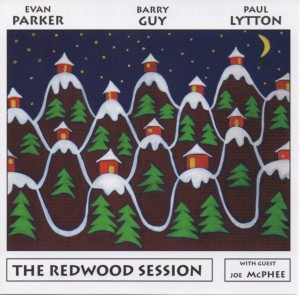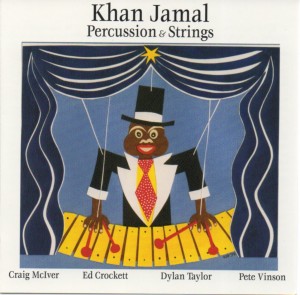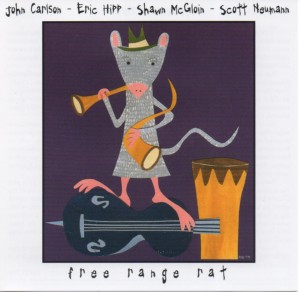Check Number 1) Ordering 10 CDs by musicians you’ve never heard, neither their music nor their names, all recorded on a label that you’ve only heard one cut of music not exactly the type you’d usually seek out, is a big risk. With nothing to go on to make my selections, I just made some random picks through the label’s catalog. I stated with their first release, and proceeded to scroll through chronologically clicking of whatever seemed intriguing. I’ve often picked up CDs on whims before, but never a whole cache of ten. It is hit ‘n miss, and the first CD, Evan Parker’s The Redwood Session was a bit of both. It is nearly an hour of maundering free-jazz. Some aficionados can listen to an entire evening of this stuff, but I gotta have something to lean on here and there. Not much on this CD gives the listener a chance to sit back and let the music take over. It’s just too scattered. On the other hand, Evan’s playing is exceptional. He does some pretty remarkable things with a saxophone, lots of multiphonics and squiggly sounds. It is attention grabbing, sometimes even fascinating. Sidemen Barry Guy, bass, Paul Lytton drums, and Joe McPhee, trumpet, follow in step to add their own eyebrow tilting elaborations.
Check Number 2 & 3) Sometimes your whims turn up surprises. Khan Jamal’s Percussion & Strings is one ear popping surprise. Yet, I guess, the instrumentation lends a clue—vibes, marimba (Jamal), bass (Ed Crockett), cello (Dylan Taylor), Drums (Craig McIver, also marimba), Pete Vinson (drums, when McIver’s on marimba). Cello? Any instrument is appropriate for jazz in the hands of talent. Oh, wait a minute, not bagpipes. After the first two cuts, I was wondering what the cello adds. Taylor’s playing isn’t particularly strong, especially his bowing technique. Perfection is something to strive for, but over polished, over wrought and labored perfection is not really perfect—there is no perfection—it’s merely tortured—and there’s way too much pseudo-perfection going around. For this reason, it’s refreshing to hear someone less then stunning like Taylor. But then, I started hearing the interplay between bass and cello (left and right channels respectively). I heard Taylor working on and counterpointing Crockett’s bass line. Taylor, when playing like a bass, is in his element. When he gets to solo, he deploys impressive improvisations.
Check Number 4) Piano, the mainstay of small group jazz, is conspicuously missing in many CIMP recordings. Along with the first two, this next CD is one of them. John Carlson, trumpet; Eric Hipp, tenor sax; Shawn McGloin, bass; and Scott Neumann, drums; had an inspiring session in The Spirit Room, Rossie, NY, back in 1998. It’s a nice blend of modern and free jazz. It hits lots of pinnacles over its eleven cuts. The album title, Free Range Rat, provides a cute sardonic ledge for the quartet to scramble over. Drummer Scott Neumann is a pinnacle on his own. Few drummers have the sensibilities of a musician. They don’t play melodies. But when I hear a drummer who’s ‘singing along’ with the other musicians, it puts a smile on my face. This is what great jazz drummers do. They play melodically. They add harmonic lines, not just rhythmic. Neumann lays down musical accompaniment that’s much more than a beat. He plays music.
Check Number 5) CIMP is Creative Improvised Music Projects, located in Redwood, New York. Who? Where? Miracles happen. They’re right in front of us, but rarely in the limelight. Here’s a recording company so tiny they only use two microphones when recording. They’re so low-tech that the only even remotely modern technique they use is digital. Their recordings are striped down simple : no equalization, no mixing, no mastering, no compression, no gain riding, no reverb, no nuttin’ is done to the musicians’ performance. They set the controls, sit back, and listen to the music like they’re one of the audience—and they listen. Who? Where? Why?
Check off Respect. Respect for the musicians, respect for the music, and respect for the listener. Their goal is to capture the performance as the musicians played it. No tricks, no fixes, no perfection—it is perfect. It’s real stereo, in a real performance space, with real musicians and real acoustics. Sometimes the bass player uses amplification, necessarily, and what we hear on the recording is the bass player’s amp, as he intends to sound, and just as if we’d been sitting right there in the room during the performance. We get to hear the sound of each instrument’s voice as it came out of the bell, the soundboard, the skin. We get to hear the natural balance of the players, who have spent years not only practicing their instrument, but practicing the equally challenging craft of blending with, backing up, or standing out from, the other musicians. We get to hear the full dynamic range—subtle breaths to piercing attacks. We get a true stereo image—an “I can almost see them” realism. We get to hear every glorious gleam and glide, and every glorious glitch. We get checked into reality.
Check out the reality unprocessed recordings reveal—
Evan Parker – “Pedal (for Warren)”
Khan Jamal – “Six + Seven Equals Thirteen”
Khan Jamal – “Witch Doctor’s Son”
John Carlson – “Range Rat Ramble”
John Carlson – “African Flower”
John Carlson – “If You Came from Nowhere Here”
(||) Rating — Music : C ║ Performance : A ║ Recording : A+ ║ Evan Parker, The Redwood Session, CIMP Ltd., 1995
(||) Rating — Music : A ║ Performance : A ║ Recording : A+ ║ Khan Jamal, Percussion & Strings, CIMP Ltd., 1997
(||) Rating — Music : A ║ Performance : A ║ Recording : A+ ║ John Carlton, Free Range Rat, CIMP Ltd., 1998
For more about real sound and Creative Improvised Music Projects see :
[Silent Distortion]
[Depth Perception]
[Canned Music]
[Creative Improvised Music Projects]
[Simplicity]
[Deep Listening]
[In & Out]
![[art]by[odo]](https://artbyodo.net/wordpress/wp-content/uploads/2011/03/cropped-Header.jpg)


